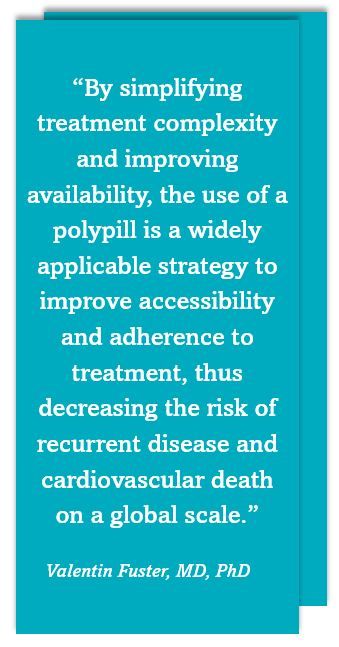Polypill Reduces Risk of MACE in Secondary Prevention for Older Adults: Results from SECURE
Taking a 3-drug polypill (aspirin, ACEi, statin) vs each of the drugs separately reduced risk for a major CV event by 33%, according to results of the SECURE trial.
A 3-drug polypill containing aspirin, ramipril, and atorvastatin prescribed within 6 months of myocardial infarction in older adults significantly reduced risk for major adverse cardiovascular (CV) events (MACE) compared with usual care.
The findings, from the international SECURE trial, were presented at the European Society of Cardiology Congress 2022.
The most notable result, according to study authors, was finding that treatment with the polypill (aspirin 100 mg, ramipril 2.5, 5 or 10 mg and atorvastatin 20 or 40 mg) was associated specifically with a 33% reduction in CV mortality vs treatment with the agents prescribed individually.

“By simplifying treatment complexity and improving availability, the use of a polypill is a widely applicable strategy to improve accessibility and adherence to treatment, thus decreasing the risk of recurrent disease and cardiovascular death on a global scale,” wrote investigators led by Valentin Fuster, MD, PhD, director of Mount Sinai Heart, physician in chief of The Mount Sinai Hospital and general director of the National Center for Cardiovascular Innovation in Madrid, Spain, in the study published simultaneously in the New England Journal of Medicine.
There is a body of evidence demonstrating that less than 50% of post-MI patients consistently take all the prescribed medications meant to lower their risk for subsequent MACE.
The phase 3, randomized controlled SECURE (Secondary Prevention of Cardiovascular Disease in the Elderly) clinical trial was conducted at 113 centers in Spain, Italy, France, Germany, Poland, the Czech Republic, and Hungary in eligible patients with a history of type 1 myocardial infarction within the previous 6 months.
Participants were randomized to a polypill-based strategy—a single pill containing aspirin (100 mg), ramipril (2.5, 5, or 10 mg), and atorvastatin (20 or 40 mg) or to usual care which consisted of taking the drugs separately at the discretion of treating physicians and following current ESC guidelines for this patient population. The primary outcome of interest was a composite of CV death, nonfatal type 1 MI, nonfatal ischemic stroke, or urgent revascularization. The key secondary end point was the composite above excluding revascularization.
Potential participants were screened between August 2016 to December 2019. After exclusions among an original 4003 patients, 2499 patients were randomly assigned to treatment with the polypill (n=1258) or to usual care (n=1241). The final cohort’s mean age was 76.0 years, 31.0% were women, and the majority was White. According to the study, more than three-quarters (78%) had hypertension, half (57%) had diabetes, and half had a history of smoking (51%).
FINDINGS
During a median follow-up of 36 months, a primary composite outcome event occurred in 118 of 1237 patients (9.5%) in the polypill group and in 156 of 1229 (12.7%) in the usual-care group (hazard ratio [HR], 0.76; 95% CI, 0.60 - 0.96; P = .02). The effect, investigators say, was similar across prespecified subgroups, including age, sex, location, prior vascular events, and regardless of presence of diabetes or chronic kidney disease.
The risk for a key secondary outcome event also was lower in the polypill-treated group, occurring in 101 participants (8.2%), than in the usual care group, occurring in 144 participants (11.7%) (HR, 0.70; 95% CI, 0.54 - 0.90; P = .005).
“The results were striking,” Fuster said during an ESC Congress press conference. “There are two points of importance. The curves begin to separate from the very beginning of the trial, and they continue to separate over time. So, one can begin to project the possibility that the results would be even more striking if the trial continues to move forward.”
“The results were striking. There are two points of importance. The curves begin to separate from the very beginning of the trial, and they continue to separate over time. So, one can begin to project the possibility that the results would be even more striking if the trial continues to move forward.”
The investigators report that adverse event rates were similar between the 2 groups—32.7% in the polypill-treated group and 31.6% in the usual care group.
Fuster et al write that the reduction in risk they observed “may be partly explained by increased adherence.” Medication adherence was higher in the polypill group at 6 months, with 70.6% of the group self-reporting following the prescribed regimen vs 62.7% of the usual care group. The difference persisted at 24 months with 74.1% in the polypill group and 63.2% in the usual care group reporting adherence (risk ratio, 1.17; 95% CI, 1.10 to 1.25).
According to the study, most patients in the polypill group (91.7%) received the 40-mg formulation of atorvastatin, while 40.4% of patients in the usual-care group were treated with a high-potency statin drug.
The investigators suggest that their findings are likely widely applicable to the general population, "especially considering that the average age at the time of a first myocardial infarction is now 65.6 years for men and 72 years for women, along with the high prevalence of diabetes mellitus, chronic kidney disease and previous coronary artery disease in these patients.”
Reference: Castellano JM, Pocock SJ, Bhatt DL, et al, for the SECURE investigators. Polypill strategy in secondary cardiovascular prevention. New Engl J Med. Published online August 26, 2022. doi:10.1056/NEJMoa2208275